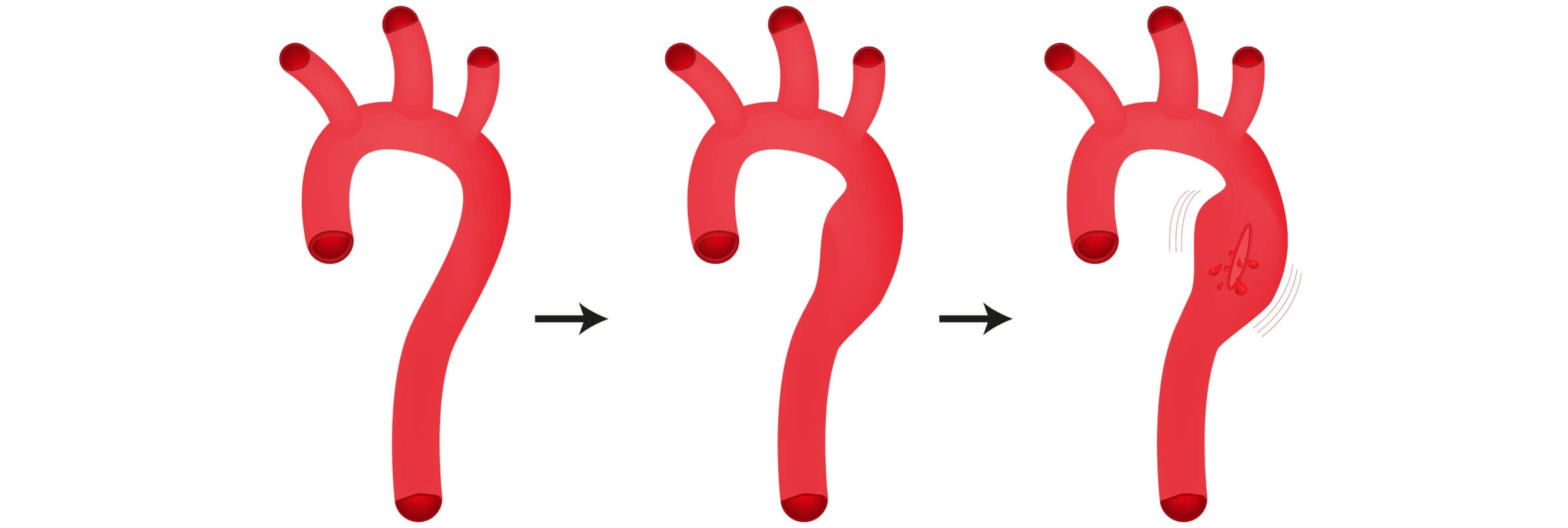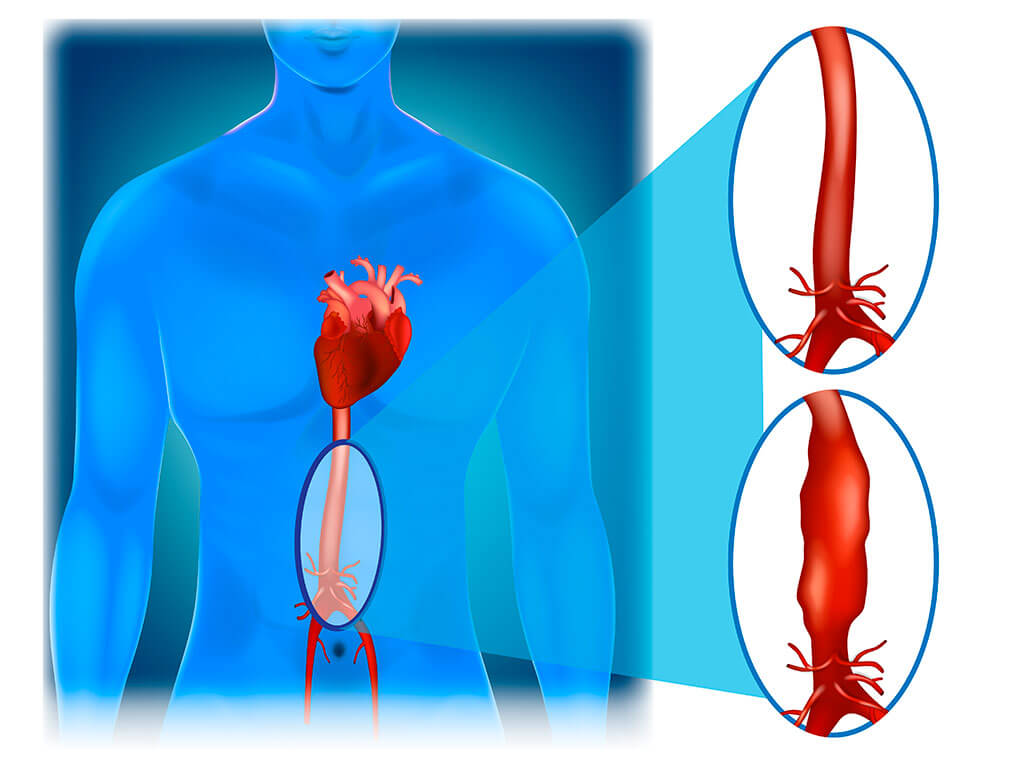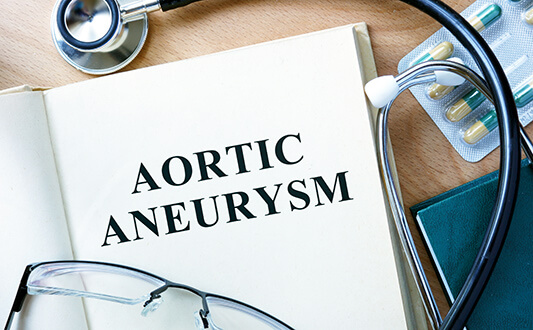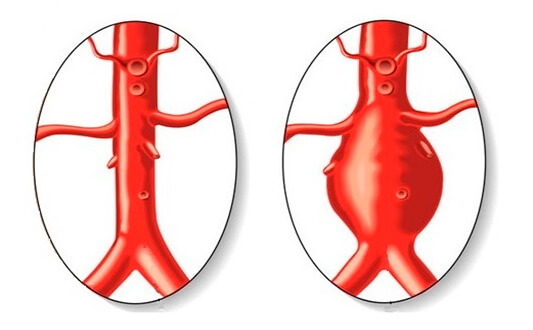An Aortic aneurysm is a life threatening disease that can lead to a patient’s death at any moment as a result of an aneurysm rupture. This diagnosis is established when the diameter of a certain artery fragment expands and exceeds the normal size by at least twice as much.
Let’s find out what an aortic aneurysm is, its symptoms and the necessary treatment.
Content
- Clinical picture of the disease
- Diagnostics
- Dissection and rupture of an aortic aneurysm
- Treatment
- Where is it better to undergo a surgery?
- Arrangement of treatment
Clinical picture of the disease
The symptoms of an aortic aneurysm depend on its location. It will be an abdominal location in 80% of cases.
Three classic symptoms of aortic aneurysm are common for this kind of pathology:
- Abdominal pain is observed in 90% of cases;
- An auscultated noise (murmur) above the aorta is observed in 75% of cases;
- It is visible or felt by the patient pulsation in the abdomen in 40% of cases.
20% of cases are located in the thoracic region, where signs and symptoms of aortic aneurysms are absent in 75% of patients.
Patients may have such complaints as:
- Heart pain or back pain;
- Dizziness, shortness of breath, weakness;
- Edema of the upper body;
- Decreased heart rate and drooling;
- Difficulty swallowing;
- Hoarseness of voice.
Sometimes, symptoms of an aortic aneurysm arise from the central nervous system. This is a focal neurological symptom associated with impaired cerebral circulation.
Such a large variety of clinical signs in the lesions of the aorta in the thoracic region is due to the fact that the widened portion of the vessel can compress various structures. These are subclavian and carotid arteries, the upper hollow vein, the vagus nerve, trachea, larynx, esophagus and other structures of the chest cavity.
Diagnostics
Diagnostics of aortic aneurysm is done by means of the following methods:
- X-ray;
- Ultrasound;
- CT;
- MRI;
- Angiography.
Diagnostics of a thoracic aortic aneurysm is most often not provided intentionally, as 3 patients out of 4 do not have any complaints. Therefore, nobody goes to the doctor.
But, an aneurysm will be determined if the following tests are taken:
- Echo-CG - ultrasound examination of the heart, which is prescribed for a suspected cardiac pathology;
- Radiographic examination of the chest, which is prescribed for suspected pneumonia, fracture of the ribs and many other pathologies.
But, in the case of abdominal localization, there are usually symptoms of an aortic aneurysm. Diagnostics is carried out purposefully. It usually starts with an ultrasound. This method allows you to detect the expanded part of the vessel and measure its diameter. Unlike a thoracic aneurysm, an abdominal aortic aneurysm is rarely found on X-ray. Firstly, because an X-ray of the abdominal cavity is much less common, and secondly, because this pathology is much harder to detect, and often it remains unnoticed in the picture.
After determining the symptoms of an aortic aneurysm, through diagnostics with an X-ray or ultrasound, refining studies are carried out. A CT or MRI makes it possible to obtain the most accurate information about the location of the enlarged part of the vessel, the state of the branches of the aorta, its walls, the presence of thrombi, etc. To increase the diagnostic value of the studies, intravenous contrasting can be used. In some cases, an angiography can be prescribed. This is an unsafe, but sometimes necessary, X-ray examination with intra-arterial contrast. It is used for suspected lesions of the aorta branches or for better planning of the operation.
Dissection and rupture of an aortic aneurysm
An aneurysm doesn’t usually cause severe symptoms by itself or bother the patient’s life quality. But, it carries the threat of complications for the patient’s life.
A dissecting aortic aneurysm is a condition that precedes a rupture. In total, the artery has three layers. If the inner one bursts, the blood begins to seep into the middle, muscle layer. The dissection continues until the vessel is completely ruptured. Dissection of the aortic aneurysm is fraught with massive internal bleeding. Therefore, if during the diagnostics it is established that the aortic aneurysm is dissecting, this is an indication for an emergency surgical intervention. If there is no treatment, an aortic aneurysm ruptures. The outcome of the disease depends on the location of the bleeding in this case. Lethal outcomes make up 60% in the cases of abdominal aorta ruptures.
Bleeding can open into:
- The retroperitoneal space - in 70% of cases;
- The duodenum - in 20% of cases;
- The abdominal cavity - in 10% of patients.
Complications are always accompanied by severe pain. With massive blood loss, paleness of the skin, shortness of breath, and the loss of consciousness is possible to observe. Without medical assistance, lethality reaches 100%. About 50% of patients die within the first day after the bleeding started, another 35% - within 1 week.
An even more dangerous pathology is a thoracic aortic aneurysm. The lethality reaches 95%. Bleeding opens into the pericardium (pericardial sac) or the mediastinal fiber. Less often there is bleeding into the esophagus or structures of the tracheobronchial tree. If the aortic aneurysm ruptures, the prognosis is unfavorable. The patient dies shortly from increasing heart failure.
Treatment
Regardless of its location, an aortic aneurysm’s treatment is only surgical. The choice of the intervention depends on the aneurysm location.
Ascending aortic aneurysm treatment is performed surgically. This pathology is handled by cardiovascular surgeons. The operation is quite complicated. The aneurysm is removed. The defect is replaced not with a synthetic prosthesis, but with its own vessel taken from another part of the body, or a formed pericardium. Aneurysm of the aortic arch treatment is similar.
Ascending aortic aneurysm indications for planned surgery are as follows:
- Clinically significant regurgitation (reverse blood flow);
- The presence of aortic heart aneurysm symptoms;
- The size of the extended section reaching 6 cm or more;
- With an aneurysm of 5 cm, if there are cases of sudden death in relatives from an anamnesis;
- With an aortic aneurysm, treatment is required if it increases in diameter by more than 1 cm per year;
- In a case with a combination with aortic valve diseases, if the diameter of the enlarged ascending aorta exceeds 4 cm.
Emergency intervention is required in cases of an abnormality being detected or a dissecting aortic aneurysm.
In cases where the location of the pathology is in the descending aortic part or in the abdominal cavity, the essence of the surgery is to replace the artery fragment with an artificial prosthesis. They can be linear and bifurcation. Bifurcation prostheses are used in cases when the infrarenal aortic lesion (below the renal artery) is spreading to the iliac arteries.
Where is it better to undergo a surgery?
As aortic aneurysm treatment is very complicated, a patient has to make the right choice of hospital. Many patients prefer to undergo quality medical assistance. One of the popular destinations is Germany.
The cost of surgery for an aortic aneurysm in German hospitals is higher than in the majority of developing countries.
Nonetheless, people often prefer to undergo surgery in Germany and there are many reasons for this:
- Highly qualified doctors work in Germany - many operations for an aortic aneurysm are very complicated, and the outcome directly depends on the skills of the cardiac surgeons team;
- All large clinics are well-equipped;
- Quality prostheses are used;
- There is a low risk of complications and intra-operative mortality.
In Germany, endovascular aortic aneurysm surgeries that do not require the opening of the abdominal cavity are widely used. Access is through the femoral or iliac artery. This provides a better postoperative tolerance, a lower risk of complications and a better aesthetic effect. After such surgical interventions, patients recover faster. In this case, the cost of surgery for the aortic aneurysm, which was conducted using an endovascular operating access, is comparable to the price of a conventional open surgery.
Based on the treatment success rates, the equipment of the hospitals and the skills of the cardiac surgeons and cardiologists, we have selected the leading hospitals for the treatment of thoracic aortic aneurysm:
- University Hospital of Ludwig-Maximilian University of Munich, Department of Vascular Surgery
- Charite University Hospital Berlin, Department of General, Abdominal and Vascular Surgery
- University Hospital Carl Gustav Carus Dresden, Department of Abdominal, Thoracic and Vascular Surgery
- University Hospital Frankfurt-am-Main, Department of Vascular and Endovascular Surgery
- University Hospital Heidelberg, Department of Vascular and Endovascular Surgery
The average cost of the main types of treatment is as follows:
- Examination for suspected thoracic aortic aneurysm – €2,730
- Open aortic replacement in thoracic aortic aneurysm – €46,330
- Endovascular aortic replacement in thoracic aortic aneurysm – €47,760
- Rehabilitation after completion of the main course of treatment – €1,030 per day
If you need treatment for an aneurysm of another part of the aorta, leave your request on the Booking Health website and a medical advisor will help you with your selection of a hospital.
Arrangement of treatment
Many patients want to have surgery in Germany, but they are held back because of a number of difficulties. We are ready to take on all the difficulties associated with the arrangement of treatment. Booking Health has been a leader in the medical tourism industry for many years.
Advantages of contacting us are:
- We will choose the best clinic for you;
- You will be operated on by an authoritative doctor, not a young, inexperienced specialist;
- The waiting time for the operation will be reduced. This is important, because an aneurysm rupture can occur at any time;
- You will save up to 70%;
- You will be insured against complications. In case of additional costs, they will be covered by an insurance company;
- You will receive a doctor's consultation within 3 months after the end of the program;
- You will not need to take care of organizational issues, hence, this will allow you to focus on your treatment and recovery after surgery.
Our specialists will translate the medical documentation for you; help to issue you a visa and book tickets. In Germany we will provide you with an interpreter and provide a transfer from the airport to the clinic and back.
Choose treatment abroad and you will be sure to get the best results!
Authors:
This article was edited by medical experts, board-certified doctors Dr. Nadezhda Ivanisova, and Dr. Bohdan Mykhalniuk. For the treatment of the conditions referred to in the article, you must consult a doctor; the information in the article is not intended for self-medication!
Our editorial policy, which details our commitment to accuracy and transparency, is available here. Click this link to review our policies.
Sources:
ECR - European Cardiology Review
National Center for Biotechnology
JAHA - Journal of the American Heart Association
Read:
Aortic aneurysm - definition, causes and classification
Don't know where to start?
Contact Booking Health







